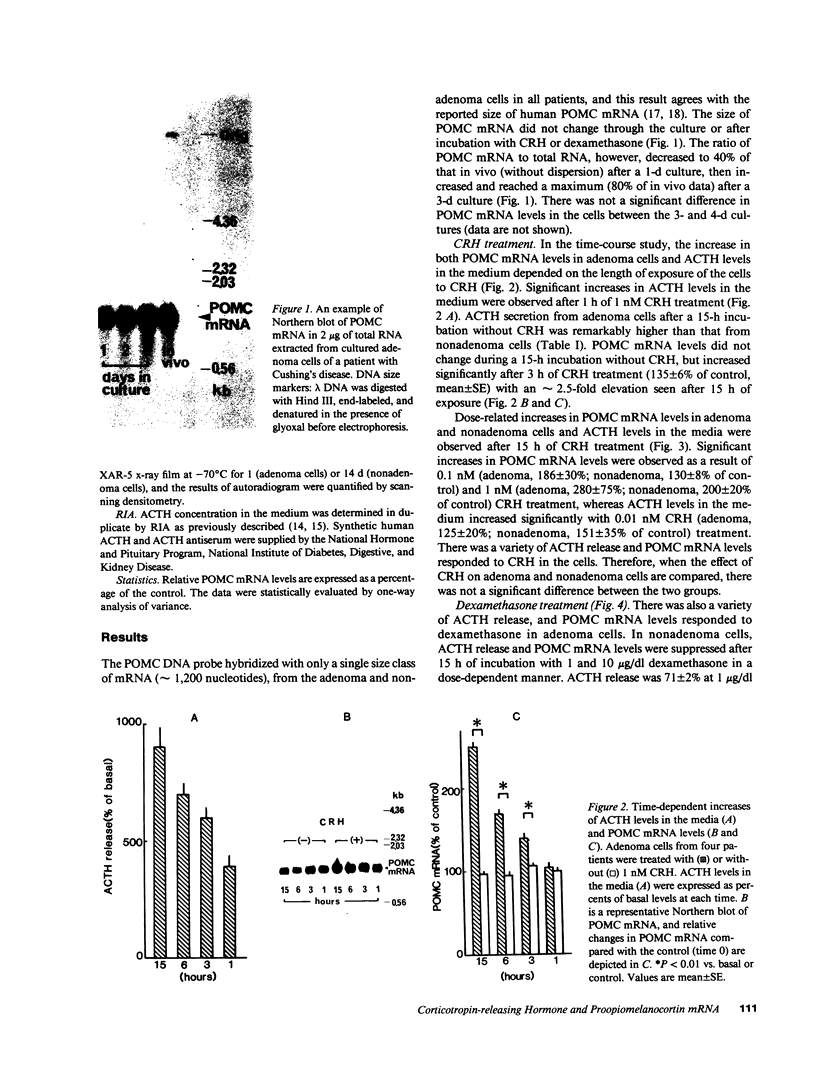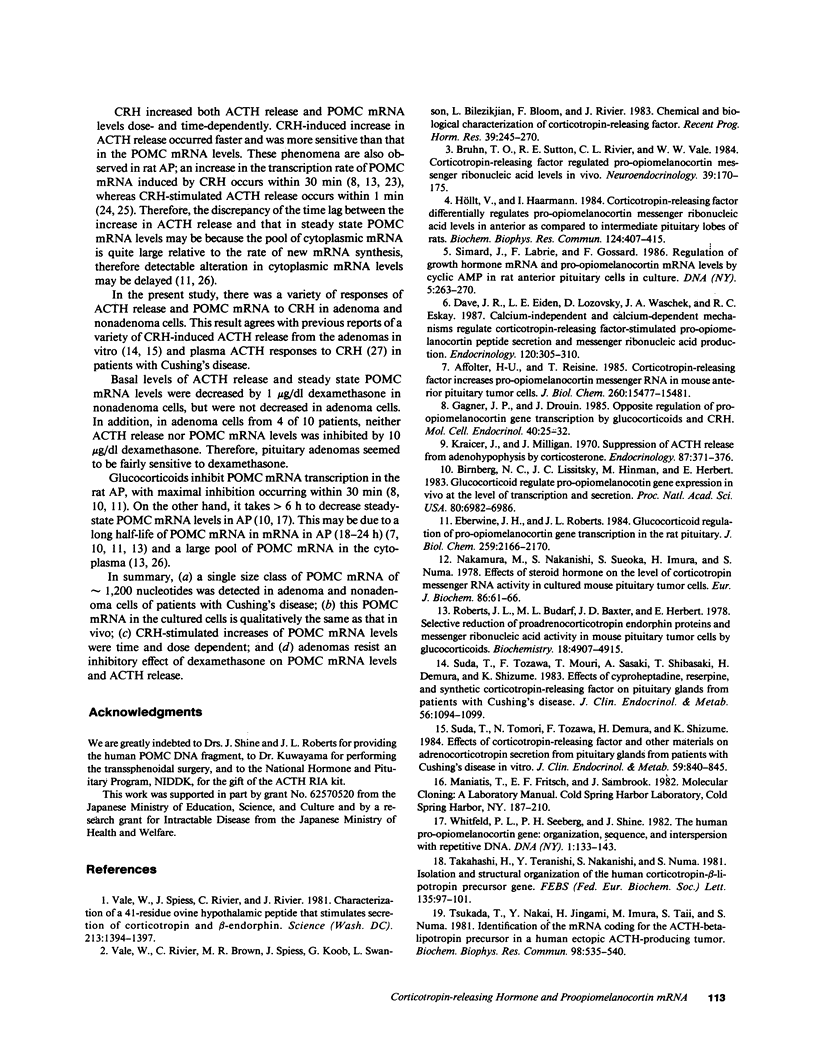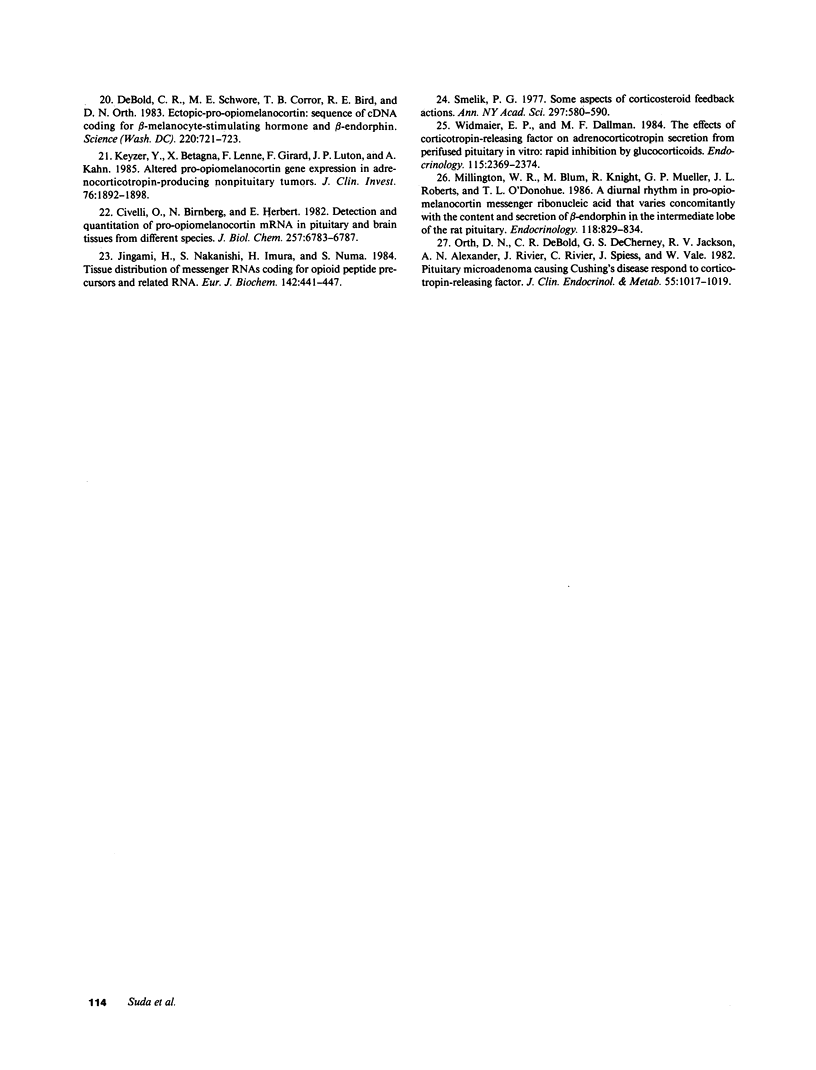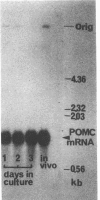Abstract
The effects of corticotropin-releasing hormone (CRH) and dexamethasone on proopiomelanocortin (POMC) mRNA levels in cultured pituitary adenoma cells were studied in 10 patients with Cushing's disease. As a control, POMC mRNA levels in cells from nonadenomatous tissues were examined in four patients. Human POMC mRNA in the cells was analyzed by Northern blot hybridization. Human POMC DNA probe hybridized with only a single size class of RNA (approximately 1,200 nucleotides) from the adenoma and nonadenoma cells of each patient. The size of POMC mRNA did not change through the culture or after incubation with CRH or dexamethasone. CRH increased POMC mRNA levels in these cells in a dose- and time-dependent manner. The minimum concentration of CRH required to elevate POMC mRNA levels in these cells exposed for 15 h was 0.1 nM. The minimum duration of 1 nM CRH treatment required to increase these levels was 3 h under our conditions. Inhibitory effects of 1 and 10 micrograms/dl dexamethasone on ACTH release and POMC mRNA levels in nonadenoma cells were greater than those in adenoma cells. These results suggest the following: (a) that the mRNA in cultured pituitary adenoma cells is qualitatively the same as that in vivo; (b) that responses of mRNA levels to CRH are time- and dose-dependent; and (c) that adenoma cells resist the inhibitory effect of dexamethasone on POMC mRNA levels and ACTH release.
Full text
PDF




Images in this article
Selected References
These references are in PubMed. This may not be the complete list of references from this article.
- Affolter H. U., Reisine T. Corticotropin releasing factor increases proopiomelanocortin messenger RNA in mouse anterior pituitary tumor cells. J Biol Chem. 1985 Dec 15;260(29):15477–15481. [PubMed] [Google Scholar]
- Birnberg N. C., Lissitzky J. C., Hinman M., Herbert E. Glucocorticoids regulate proopiomelanocortin gene expression in vivo at the levels of transcription and secretion. Proc Natl Acad Sci U S A. 1983 Nov;80(22):6982–6986. doi: 10.1073/pnas.80.22.6982. [DOI] [PMC free article] [PubMed] [Google Scholar]
- Bruhn T. O., Sutton R. E., Rivier C. L., Vale W. W. Corticotropin-releasing factor regulates proopiomelanocortin messenger ribonucleic acid levels in vivo. Neuroendocrinology. 1984 Aug;39(2):170–175. doi: 10.1159/000123974. [DOI] [PubMed] [Google Scholar]
- Civelli O., Birnberg N., Herbert E. Detection and quantitation of pro-opiomelanocortin mRNA in pituitary and brain tissues from different species. J Biol Chem. 1982 Jun 25;257(12):6783–6787. [PubMed] [Google Scholar]
- Dave J. R., Eiden L. E., Lozovsky D., Waschek J. A., Eskay R. L. Calcium-independent and calcium-dependent mechanisms regulate corticotropin-releasing factor-stimulated proopiomelanocortin peptide secretion and messenger ribonucleic acid production. Endocrinology. 1987 Jan;120(1):305–310. doi: 10.1210/endo-120-1-305. [DOI] [PubMed] [Google Scholar]
- DeBold C. R., Schworer M. E., Connor T. B., Bird R. E., Orth D. N. Ectopic pro-opiolipomelanocortin: sequence of cDNA coding for beta-melanocyte-stimulating hormone and beta-endorphin. Science. 1983 May 13;220(4598):721–723. doi: 10.1126/science.6301015. [DOI] [PubMed] [Google Scholar]
- Eberwine J. H., Roberts J. L. Glucocorticoid regulation of pro-opiomelanocortin gene transcription in the rat pituitary. J Biol Chem. 1984 Feb 25;259(4):2166–2170. [PubMed] [Google Scholar]
- Gagner J. P., Drouin J. Opposite regulation of pro-opiomelanocortin gene transcription by glucocorticoids and CRH. Mol Cell Endocrinol. 1985 Apr;40(1):25–32. doi: 10.1016/0303-7207(85)90154-6. [DOI] [PubMed] [Google Scholar]
- Höllt V., Haarmann I. Corticotropin-releasing factor differentially regulates proopiomelanocortin messenger ribonucleic acid levels in anterior as compared to intermediate pituitary lobes of rats. Biochem Biophys Res Commun. 1984 Oct 30;124(2):407–415. doi: 10.1016/0006-291x(84)91568-7. [DOI] [PubMed] [Google Scholar]
- Jingami H., Nakanishi S., Imura H., Numa S. Tissue distribution of messenger RNAs coding for opioid peptide precursors and related RNA. Eur J Biochem. 1984 Aug 1;142(3):441–447. doi: 10.1111/j.1432-1033.1984.tb08306.x. [DOI] [PubMed] [Google Scholar]
- Kraicer J., Milligan J. V. Suppression of ACTH release from adenophypophysis by corticosterone: an in vitro study. Endocrinology. 1970 Aug;87(2):371–376. doi: 10.1210/endo-87-2-371. [DOI] [PubMed] [Google Scholar]
- Millington W. R., Blum M., Knight R., Mueller G. P., Roberts J. L., O'Donohue T. L. A diurnal rhythm in proopiomelanocortin messenger ribonucleic acid that varies concomitantly with the content and secretion of beta-endorphin in the intermediate lobe of the rat pituitary. Endocrinology. 1986 Feb;118(2):829–834. doi: 10.1210/endo-118-2-829. [DOI] [PubMed] [Google Scholar]
- Nakamura M., Nakanishi S., Sueoka S., Imura H., Numa S. Effects of steroid hormones on the level of corticotropin messenger RNA activity in cultured mouse-pituitary-tumor cells. Eur J Biochem. 1978 May;86(1):61–66. doi: 10.1111/j.1432-1033.1978.tb12284.x. [DOI] [PubMed] [Google Scholar]
- Orth D. N., DeBold C. R., DeCherney G. S., Jackson R. V., Alexander A. N., Rivier J., Rivier C., Spiess J., Vale W. Pituitary microadenomas causing Cushing's disease respond to corticotropin-releasing factor. J Clin Endocrinol Metab. 1982 Nov;55(5):1017–1019. doi: 10.1210/jcem-55-5-1017. [DOI] [PubMed] [Google Scholar]
- Roberts J. L., Budarf M. L., Baxter J. D., Herbert E. Selective reduction of proadrenocorticotropin/endorphin proteins and messenger ribonucleic acid activity in mouse pituitary tumor cells by glucocorticoids. Biochemistry. 1979 Oct 30;18(22):4907–4915. doi: 10.1021/bi00589a019. [DOI] [PubMed] [Google Scholar]
- Simard J., Labrie F., Gossard F. Regulation of growth hormone mRNA and pro-opiomelanocortin mRNA levels by cyclic AMP in rat anterior pituitary cells in culture. DNA. 1986 Aug;5(4):263–270. doi: 10.1089/dna.1986.5.263. [DOI] [PubMed] [Google Scholar]
- Smelik P. G. Some aspects of corticosteroid feedback actions. Ann N Y Acad Sci. 1977 Oct 28;297:580–590. doi: 10.1111/j.1749-6632.1977.tb41884.x. [DOI] [PubMed] [Google Scholar]
- Suda T., Tomori N., Tozawa F., Demura H., Shizume K. Effects of corticotropin-releasing factor and other materials on adrenocorticotropin secretion from pituitary glands of patients with Cushing's disease in vitro. J Clin Endocrinol Metab. 1984 Nov;59(5):840–845. doi: 10.1210/jcem-59-5-840. [DOI] [PubMed] [Google Scholar]
- Suda T., Tozawa F., Mouri T., Sasaki A., Shibasaki T., Demura H., Shizume K. Effects of cyproheptadine, reserpine, and synthetic corticotropin-releasing factor on pituitary glands from patients with Cushing's disease. J Clin Endocrinol Metab. 1983 Jun;56(6):1094–1099. doi: 10.1210/jcem-56-6-1094. [DOI] [PubMed] [Google Scholar]
- Tsukada T., Nakai Y., Jingami H., Imura H., Taii S., Nakanishi S., Numa S. Identification of the mRNA coding for the ACTH-beta-lipotropin precursor in a human ectopic ACTH-producing tumor. Biochem Biophys Res Commun. 1981 Jan 30;98(2):535–540. doi: 10.1016/0006-291x(81)90873-1. [DOI] [PubMed] [Google Scholar]
- Vale W., Rivier C., Brown M. R., Spiess J., Koob G., Swanson L., Bilezikjian L., Bloom F., Rivier J. Chemical and biological characterization of corticotropin releasing factor. Recent Prog Horm Res. 1983;39:245–270. doi: 10.1016/b978-0-12-571139-5.50010-0. [DOI] [PubMed] [Google Scholar]
- Vale W., Spiess J., Rivier C., Rivier J. Characterization of a 41-residue ovine hypothalamic peptide that stimulates secretion of corticotropin and beta-endorphin. Science. 1981 Sep 18;213(4514):1394–1397. doi: 10.1126/science.6267699. [DOI] [PubMed] [Google Scholar]
- Whitfeld P. L., Seeburg P. H., Shine J. The human pro-opiomelanocortin gene: organization, sequence, and interspersion with repetitive DNA. DNA. 1982;1(2):133–143. doi: 10.1089/dna.1.1982.1.133. [DOI] [PubMed] [Google Scholar]
- Widmaier E. P., Dallman M. F. The effects of corticotropin-releasing factor on adrenocorticotropin secretion from perifused pituitaries in vitro: rapid inhibition by glucocorticoids. Endocrinology. 1984 Dec;115(6):2368–2374. doi: 10.1210/endo-115-6-2368. [DOI] [PubMed] [Google Scholar]
- de Keyzer Y., Bertagna X., Lenne F., Girard F., Luton J. P., Kahn A. Altered proopiomelanocortin gene expression in adrenocorticotropin-producing nonpituitary tumors. Comparative studies with corticotropic adenomas and normal pituitaries. J Clin Invest. 1985 Nov;76(5):1892–1898. doi: 10.1172/JCI112184. [DOI] [PMC free article] [PubMed] [Google Scholar]





